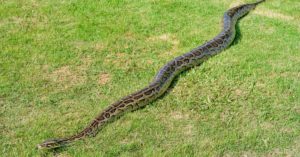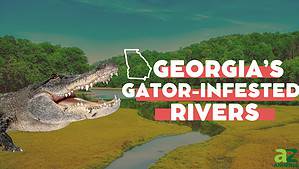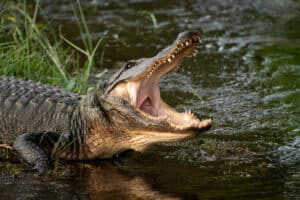Orange Lake is one of Florida’s alligator-infested lakes. However, there have been no reported fatal alligator attacks there. The lake is home to thousands of gators, only a few of which measure big enough to be known as bull gators. Alligators in Florida are a fact of life, and as both human and alligator populations increase, it’s more important than ever to understand these incredible reptilians.
Here, we’ll discover more about the American alligator, starting with how big they grow and what they look like. We’ll learn about their diet and behavior, and even where they live. Then, we’ll discover why Orange Lake is one of Florida’s alligator-infested lakes. Finally, we’ll go over which Florida lakes are home to the largest populations of gators and how to stay safe around these powerful apex predators.
Read on to learn more about alligators in Orange Lake!
American Alligators: Background
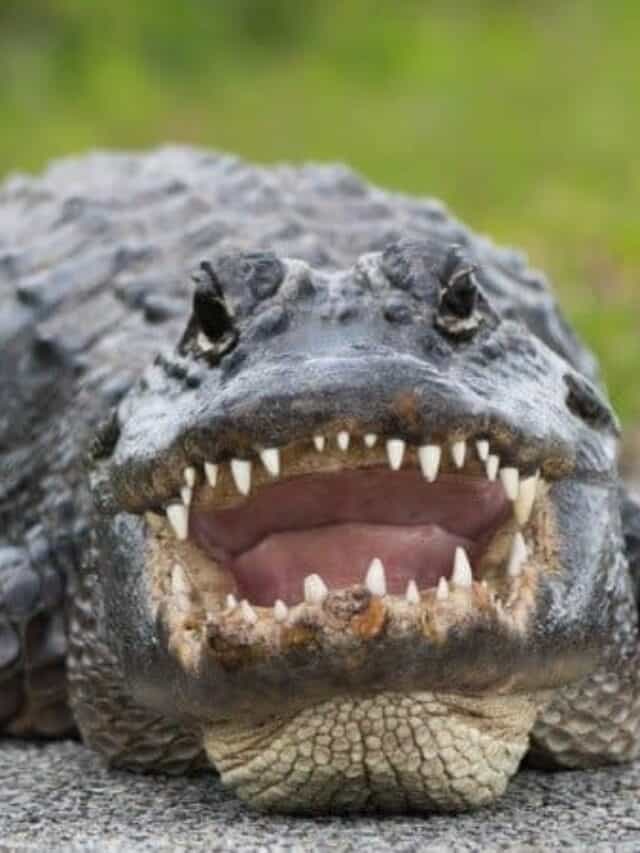
There are only two species of alligator in the world; the American alligator and the
Chinese alligator
.
©iStock.com/tobiasfrei
American alligators, along with crocodiles and Burmese pythons, are some of the largest reptilians in North America. They’ve been around for nearly 40 million years and are native to the southeastern portion of the United States. Every year, alligators attack and sometimes kill a handful of people in or near freshwater sources in Florida and other states. In 2022 alone, there have been three recorded fatalities attributed to alligators. Luckily, there have been no recorded fatal attacks at Orange Lake, one of Florida’s most famous alligator-infested lakes.
Size and Appearance
Adult alligators grow up to 15 feet long and may weigh over 1,000 pounds. Most grow to 9-10 feet, with only the largest gators topping 10 feet. Like crocodiles, they’re semi-aquatic reptiles that look like nothing so much as overgrown, armored lizards. One of the easiest ways to tell the difference between an alligator and a crocodile is by looking at their teeth. When an alligator closes its mouth, you can only see its top teeth.
Alligators tend towards dark olive green, with pale stomachs. They have blunt, wide skulls with large, conical teeth. A good portion of their length comes from their tail, which functions both to swim and to help them bring down prey.
Diet and Behavior

Alligators spend most of their time in the water.
©iStock.com/LagunaticPhoto
Alligators are apex predators who rely on lying in wait to ambush and kill prey. Young gators in Florida’s alligator-infested lakes eat insects, arthropods, mollusks, rodents, frogs, toads, small birds, and bird eggs. As they grow, their food grows too. Adult alligators eat smaller gators, turtles, birds, mammals — including deer and wild pigs — fish, amphibians, and anything else that strays too close.
Range and Habitat
American alligators are native to the southeastern United States. They live in freshwater throughout Florida, Georgia, Alabama, Louisiana, South Carolina, coastal North Carolina, and coastal Texas. They can even be found in Mississippi and some parts of Oklahoma and Arkansas.
Alligators make use of all freshwater environments, including swamps, ponds, lakes, rivers, wetlands, and drainage canals. They’re particularly fond of heavily vegetated areas with silty bottoms or cloudy water; all the better for remaining hidden.
Why Orange Lake Is One of Florida’s Alligator-Infested Lakes
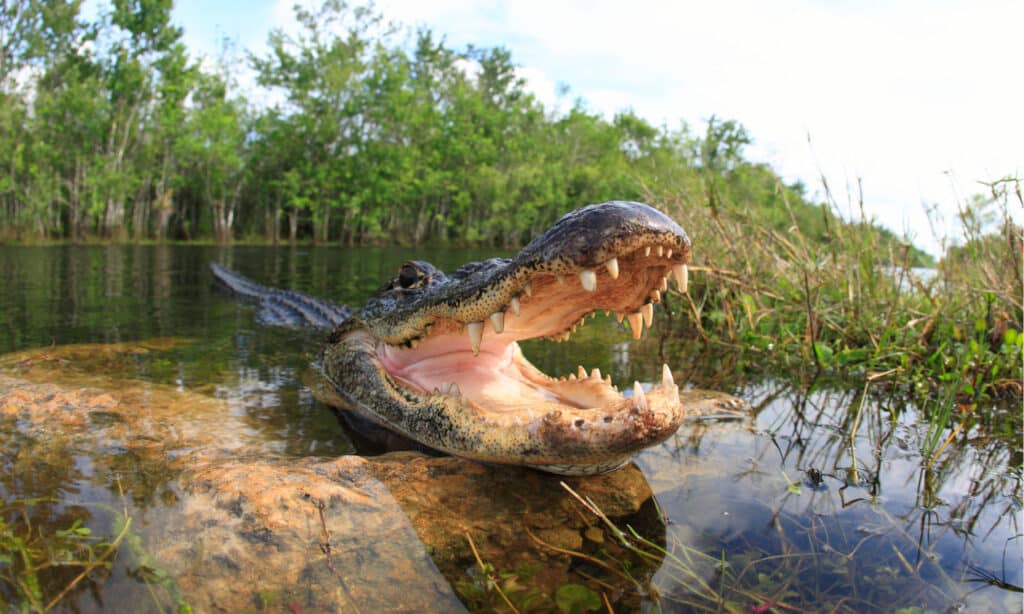
Orange Lake can boast of about 3,000 alligators!
©Thierry Eidenweil/Shutterstock.com
According to an alligator count conducted by the Florida Fish and Wildlife Conservation Commission, there are nearly 3,000 alligators living in the waters of Orange Lake. The study doesn’t just measure how many gators there are though, it also measures how many bull gators inhabit the lake. A bull gator is one that is over nine feet long. In 2021, there were an estimated 115 bull gators living in Orange Lake.
With over 1.3 million alligators living in Florida today, 3,000 might not seem like a lot. But, it’s about ⅓ the number of gators living in the largest of Florida’s alligator-infested lakes. With it’s comparatively diminutive 19 square miles, Orange Lake is an alligator haven. So, if you’re thinking about taking a dip in the shallow waters of Orange Lake, maybe think again.
Where Is Orange Lake Located on a Map?
Orange Lake is in Alachua County. It is within the Orange Creek Basin, which is part of the Oklawaha River watershed. The lake is located around 10 miles south of Hawthorne and 20 miles southeast of Gainesville.
Are There Any Lakes in Florida Without Alligators?
Florida is home to over one million alligators — that’s a lot! But, just where do all those gators live? Alligators actually live in all of Florida’s freshwater. Whether it be a river, lake, stream, or even suburban canal, chances are good there’s a gator in it. The only real way to avoid alligators in Florida is by swimming in saltwater, far from any freshwater inlet.
What Lake in Florida Has the Most Alligators?
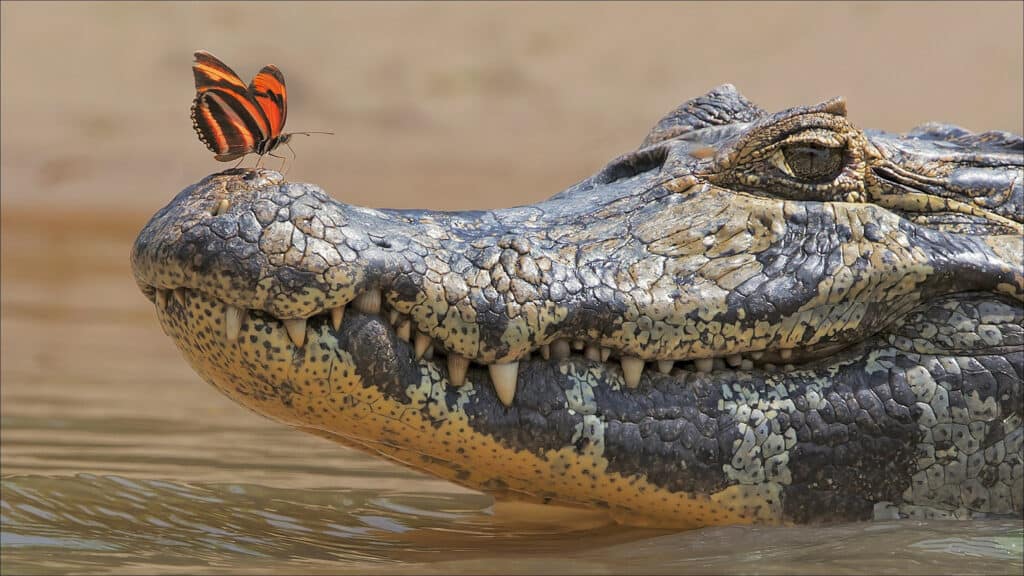
Lake Okeechobee in Florida has the highest population of alligators.
©iStock.com/Maryna Rayimova
The biggest of Florida’s alligator-infested lakes is Lake Okeechobee. This lake covers an astounding 730 square miles of land. And, its average depth is only nine feet. Nearly ten thousand alligators call Lake Okeechobee home as of the last count. This lake is much larger than Orange Lake, but, per square mile, Orange Lake actually has more gators than any other lake in Florida.
Staying Safe Around Alligators in Orange Lake
The number one rule in alligator safety is not feeding alligators. Never feed a gator, no matter how small or cute it might look. Also, never stray closer than 10 feet away from the shore of a lake, river, or other source of water. And, don’t go swimming unless you’re in an area specifically designated as safe for swimmers, like a resort pool. If you have pets or children, be sure to keep them far from the water’s edge as well. Finally, if you suspect you’ve come across an alligator nest, leave it alone, and exit the immediate vicinity immediately. Mother alligators can be fiercely protective of their young.
The photo featured at the top of this post is © Thierry Eidenweil/Shutterstock.com
Thank you for reading! Have some feedback for us? Contact the AZ Animals editorial team.



